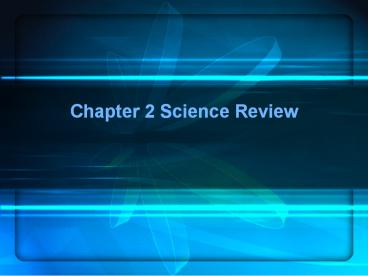Chapter 2 Science Review - PowerPoint PPT Presentation
1 / 14
Title:
Chapter 2 Science Review
Description:
Environmental Science Some areas of ES research are ... Constants All other variables influencing the outcome Inductive vs. Deductive Reasoning Inductive Moves ... – PowerPoint PPT presentation
Number of Views:272
Avg rating:3.0/5.0
Title: Chapter 2 Science Review
1
- Chapter 2 Science Review
2
Environmental Science
- Some areas of ES research are experimental and
lab-based - Most research is field-based, involving the study
of highly complex FEEDBACK LOOPS - ES research is characterized by
- A focus on CONNECTIONS INTERACTIONS
- LONG time periods
- SYNERGISTIC connections
3
(No Transcript)
4
Experimental Design
- Problem
- Question to be answered
- Hypothesis
- Scientifically testable statement
- Independent or Manipulated Variable
- The one(s) being tested or changed
- Dependent or Responding Variable
- The one(s) being measured
- Control Group
- No M.V. (for comparison)
- Constants
- All other variables influencing the outcome
5
Inductive vs. Deductive Reasoning
- Inductive
- Moves from specific observations to broader
generalizations and theories.
- Deductive
- Works from more general to more specific.
6
Precision vs. Accuracy
- Accuracy
- The nearness of a measurement to an agreed
standard (ex. how close to 1kg is a 1kg standard
weight on a particular balance?) - Precision
- The degree of reproducibility and consistency of
a measuring device throughout multiple
measurements
7
Energy Matter
- Fixed amounts of each in the universe
- Can be converted interchangeably (e mc2)
- Earth is an open system regarding energy
- Earth is a closed system regarding matter
- Energy Mass Laws
- 1 Energy/Matter cannot be created or destroyed
- 2 Energy is always converted to lower quality
forms whenever work is done
8
High vs. Low Quality Matter
- High Quality Matter
- Concentrated, easy to extract
- Low Quality Matter
- Dispersed, difficult to extract
9
Atomic Structure
- The nucleus is tiny and very dense
- The volume is almost entirely the electron cloud
10
Nuclear Chemistry Review
- Three types of radiation
- Alpha (He nucleus)
- Beta (electrons)
- Gamma (EMR wave)
- Differences in penetration
- Alpha (sheet of paper)
- Beta (block of wood)
- Gamma (concrete wall)
11
Fission and Fusion
- Fission
- 1 nucleus splits into fragments (chain reaction)
- Ex. Nuclear reactor
- Fusion
- 2 or more nuclei fuse together
- Ex. The Sun
12
Energy Laws
- First Law
- Energy cannot be created or destroyed, only
transformed or converted between different forms - Ex. Solar energy to chemical energy during
Photosynthesis - During work, energy in ALWAYS equals energy
out - You cannot get something for nothing
- Second Law
- During work, some energy is degraded into lower
quality forms - High Quality (ex. Electricity, Nuclear Fission)
- Medium Quality (ex. Normal sunlight)
- Low Quality (ex. Geothermal heat)
- You always end up with less useable energy than
you start with - You cannot break even
13
Electromagnetic Spectrum
14
Types of Pollution
- Degradable
- Ex. Human sewage, organic matter
- Persistent
- Ex. DDT, certain plastics, laminates
- Non-degradable
- Ex. heavy metals, lead mercury































